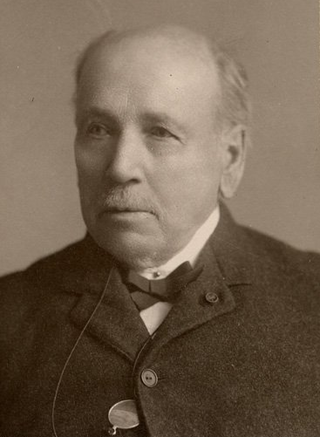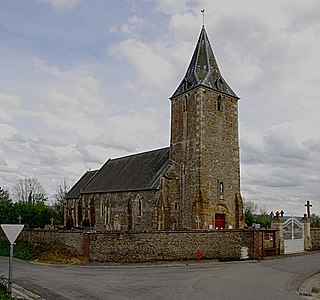
Saint-Eustache is an off-island suburb of Montreal, in western Quebec, Canada, west of Montreal on the north shore of the Rivière des Mille Îles. It is located 35 km (22 mi) northwest of Montreal.

Verdun is a borough (arrondissement) of the city of Montreal, Quebec, located in the southeastern part of the island.

Saint James United Church is a heritage church in the city's downtown core of Montreal, Quebec, Canada. It is a Protestant church affiliated with the United Church of Canada. It is located at 463 Saint Catherine Street West between Saint Alexandre and City Councillors Streets, in the borough of Ville-Marie within Downtown Montreal. It was designated as a National Historic Site of Canada in 1996.

Beaumont-de-Pertuis is a commune in the Vaucluse department in the Provence-Alpes-Côte d'Azur region in southeastern France.

Saint-Séverin is a parish municipality in Quebec (Canada) in the Mékinac Regional County Municipality, Quebec, in the administrative region of Mauricie and watershed the Batiscanie. At various times, the place was also known as Saint-Séverin-de-Proulxville and Proulxville.

Charles Baillairgé was an architect, land surveyor, civil engineer, and an author.
The Saint-Nicolas Heritage Site is a small municipal historic district located in the western part of Lévis, Quebec. It encompasses a group of a half-dozen properties and their dependencies that developed around the estate of a major family. Most of the buildings date from the 19th century, with the oldest dating from the mid-18th century. Two of them were later separately designated historic monuments at the provincial level. The site was the second designated in the province.

The Maison Saint-Gabriel Museum is located in Montreal, Quebec and is dedicated to preserving the history, heritage and artifacts of the settlers of New France in the mid 17th century. The museum consists of a small farm, which has been administered for more than 300 years by the Sisters of the Congregation of Notre Dame of Montreal, founded by Marguerite Bourgeoys in Montreal in 1658.

The Grand séminaire de Montréal is the centre for priestly formation of the Roman Catholic Archdiocese of Montreal.

Les Bergeronnes is a municipality in the Côte-Nord region of the province of Quebec in Canada. The municipality includes the communities of Grandes-Bergeronnes, Petites-Bergeronnes and Bon-Désir.

Sainte-Geneviève-de-Berthier is a municipality in the Lanaudière region of Quebec, Canada, part of the D'Autray Regional County Municipality. It is crossed by the river La Chaloupe. The Saint-Joseph River also passes over 2.1 km in the southwestern part of the municipal territory.

Ludger Lemieux was a Quebec architect who designed a number of notable Art deco structures in Montreal's Saint-Henri district. While he often worked in partnership with Joseph-Honoré MacDuff, his best-known structure, the Atwater Market, was designed not with MacDuff but with his son Paul M. Lemieux.

St. Michel de Sillery Church is a Roman Catholic parish church in Sillery, Quebec City. It is situated between Quebec Route 136 to the south and the College of Jesus and Mary of Sillery to the north, and is part of the Sillery Heritage Site in the borough of Sainte-Foy–Sillery–Cap-Rouge. Although the current church was built in 1852, and originally dedicated to the Irish Saint Columba, the parish was founded in 1644, with a chapel constructed on the same site by the Jesuits.

Thury-Harcourt-le-Hom is a commune in the department of Calvados, northwestern France. The municipality was established on 1 January 2016 by merger of the former communes of Thury-Harcourt, Caumont-sur-Orne, Curcy-sur-Orne, Hamars and Saint-Martin-de-Sallen.

The Sillery Heritage Site is an area containing historic residences and institutional properties located in the Sainte-Foy–Sillery–Cap-Rouge borough of Quebec City, Quebec, Canada. It was the first of 13 declared heritage sites of the Province of Quebec, and is among the four of which are located in Quebec City. Having been called the "cradle of the French Canadian nation," the heritage site includes approximately 350 buildings along 3.5 kilometres of the Saint Lawrence River shoreline. The Sillery Heritage Site includes buildings constructed during every major period of Quebec's history, dating back to the time of New France.

Saint-Henri Church is a former Roman Catholic church in Montreal, Quebec, Canada. It is located at 872 du Couvent Street in the Saint-Henri neighbourhood of the Southwest borough.

The church of St. Peter and St. Paul, formally the church of Saint Peter and Saint Paul du Haut-Montreuil, is a Roman Catholic church in Montreuil, Seine-Saint-Denis, France. It was the parish church of the royal Château de Vincennes.

The Church of St. Quentin is a Roman Catholic parish church in Tournai, Belgium. The largely Romanesque building is located on the main square of the town, the Grand-Place.

Maison Joseph-Gauvreau is a heritage building located in Rimouski, in the Bas-Saint-Laurent region of Quebec. Constructed in 1906 and 1907 for Dr. Joseph Gauvreau, this eclectic-style bourgeois home served as his principal residence, as well as housing his medical practice and hydrotherapy clinic, whose fame spread throughout Quebec. Gauvreau was also one of the pioneers of hygiene and preventive medicine in Quebec. The amputation of one of his arms in 1909 forced him to give up medical practice and relocate to Montreal.






















